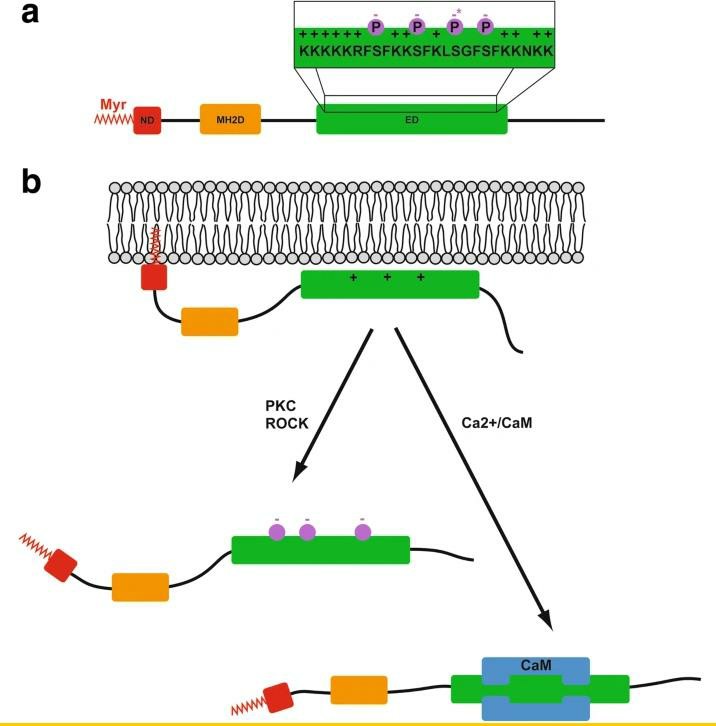What is MARCKS Protein?
The myristoylated alanine-rich C-kinase substrate (MARCKS) is a protein that plays a fundamental role in the proper functioning of the human body. This protein was discovered by McLaughlin and Aderem in 1980 during studies examining the regulation of actin cytoskeleton (structure that maintains cell shape, allows some cellular mobility, and manages chromosomal and organelle movement).
The human MARCKS gene is located on the long arm of chromosome 6, on locus 6q22.1, with a size of approximately 7.2 kilo base pairs (kbp). It contains three exons and two introns. The protein encoded by the MARCKS gene has a molecular weight of approximately 32 kDa and consists of 332 amino acid residues that feature multiple phosphorylation sites, a myristoylation site, and a polybasic effector domain (ED) for phosphatidylinositol 4,5-bisphosphate (PIP2) and Calcium ions (Ca2+) binding. These structural elements are critical for MARCKS to perform its various functional roles.

Fig1. MARCKS protein structure and electrostatic switch
Function of MARCKS protein
Functionally, the MARCKS protein is integral to cellular processes such as cell migration, neurosecretion, and the regulation of the actin cytoskeleton through its primary mode of action as a cellular substrate for protein kinase C (PKC) and other proline-directed protein kinases. When PKC phosphorylates MARCKS, it transiently dissociates from the membrane, allowing an increase in the concentration of free PIP2 and actin filament cross-linking, affecting the organization of the cell's actin cytoskeleton. Besides acting as a kinase substrate, MARCKS also serves as a significant regulator of phospholipid-mediated cellular processes, particularly concerning PIP2-signaling systems.
MARCKS protein related signal pathway
MARCKS plays key roles in numerous intracellular signaling pathways, predominantly involved in the regulation of the PKC pathway, growth factor-mediated pathways, Rho-associated kinase pathway, and Ca2+ pathway. Its involvement in these pathways is critical for modulating cellular functions like cell adhesion, motility, and cell proliferation.
MARCKS protein related diseases
Due to its central role in numerous cellular processes, any dysfunction or dysregulation of the MARCKS protein has been implicated in numerous diseases, including neurodegenerative diseases, chronic obstructive pulmonary disease (COPD), cancer, and cognitive deficits. Alzheimer's disease, for instance, has been linked to the abnormal phosphorylation of MARCKS, which disturbs the distribution of the protein in neuronal cells. Similarly, several types of cancers, including lung, breast, glioma, and colorectal, have been shown to harbor abnormalities in MARCKS expression and its phosphorylation status.
MARCKS protein's applications in biomedical
From a biomedical perspective, the properties and distinct roles of the MARCKS protein also present exciting prospects for therapeutic interventions. For instance, due to MARCKS's function in cell migration and its implications in disease pathology, the inhibition of MARCKS can potentially serve as a strategy to slow down or block the invasiveness of cancer cells. Similarly, in neurodegenerative diseases such as Alzheimer's, therapeutic efforts are directed towards normalizing MARCKS distribution and phosphorylation status in affected neurons. In pulmonary diseases too, MARCKS proteins have been shown to modulate mucus secretion, providing a potential therapeutic target for diseases associated with mucus hypersecretion like asthma and COPD.
In conclusion, the MARCKS protein is a remarkable molecular entity with wide-ranging functions across numerous cellular processes. Its roles in health and disease are still being deciphered, and further investigation into its complex actions promises to reveal valuable therapeutic and diagnostic applications. From its discovery in the 1980s to its applications in medical treatment modalities, the MARCKS protein epitomizes the essence of biomolecular research and its contributions to human health.
Our Featured Products
| Cat.No. | Product Name | Species | Source (Host) | Tag |
|---|---|---|---|---|
| MARCKS-16H | Recombinant Human MARCKS protein, MYC/DDK-tagged | Human | HEK293 | Myc/DDK |
| MARCKS-17H | Recombinant Human MARCKS protein, GST-tagged | Human | Wheat Germ | GST |
| MARCKS-1097H | Recombinant Human MARCKS Protein, His&SUMO-tagged | Human | E.coli | N-His&SUMO |
| MARCKS-1369H | Recombinant Human MARCKS Protein, His (Fc)-Avi-tagged | Human | HEK293 | His (Fc)-Avi |
| MARCKS-5590HFL | Recombinant Full Length Human MARCKS protein, Flag-tagged | Human | Mamanlian cells | Flag |
| MARCKS-395HFL | Active Recombinant Full Length Human MARCKS Protein, C-Flag-tagged | Human | Mammalian cells | Flag |
Reference
- El Amri, M., Fitzgerald, U. & Schlosser, G. MARCKS and MARCKS-like proteins in development and regeneration. J Biomed Sci 25, 43 (2018). https://doi.org/10.1186/s12929-018-0445-1

